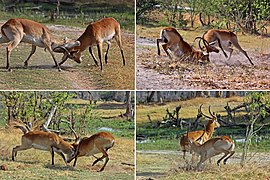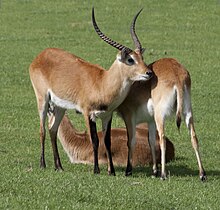Lechwe
| Lechwe | |
|---|---|
 | |
| male K. l. leche Nkasa Rupara National Park, Namibia | |
Conservation status | |
CITES Appendix II (CITES)[2] | |
| Scientific classification | |
| Domain: | Eukaryota |
| Kingdom: | Animalia |
| Phylum: | Chordata |
| Class: | Mammalia |
| Order: | Artiodactyla |
| Family: | Bovidae |
| Genus: | Kobus |
| Species: | K. leche |
| Binomial name | |
| Kobus leche Gray, 1850 | |
| Subspecies | |
| |
 | |
| Distribution range of lechwe | |
| Synonyms | |
| Onotragus leche | |
The lechwe, red lechwe, or southern lechwe (Kobus leche) is an antelope found in wetlands of south-central Africa.
Range
The lechwe is native to Botswana, Zambia, southeastern Democratic Republic of the Congo, northeastern Namibia, and eastern Angola, especially in the Okavango Delta, Kafue Flats, and Bangweulu Wetlands. The species is fairly common in zoos and wild animal farms.
Description
Adult lechwe typically stand 90 to 100 cm (35 to 39 in) at the shoulder and generally weigh from 50 to 120 kg (110 to 260 lb), with males being larger than females. They are golden brown with white bellies. Males are darker in colour, but exact hue and amount of blackish on the front legs, chest and body varies depending on subspecies. The long, spiral horns are vaguely lyre-shaped and borne only by males. The hind legs are somewhat longer in proportion than in other antelopes to ease long-distance running on marshy soil.
-
 Adult red lechwes in the Okavango Delta, Botswana
Adult red lechwes in the Okavango Delta, Botswana -
 Female red lechwe,
Female red lechwe,
Okavango Delta -
 Juvenile red lechwe,
Juvenile red lechwe,
Okavango Delta -
 Male red lechwes fighting,
Male red lechwes fighting,
Okavango Delta
Habitats
Lechwe are found in marshy areas where they are an important herbivore of aquatic plants, as well as grasses that are found in flooded meadows.[3][4] They use the knee-deep water as protection from predators. Their legs are covered in a water-repellant substance which allows them to run quite fast in knee-deep water. Lechwe are diurnal. They gather in herds which can include many thousands of individuals.[5] Herds are usually all of one sex, but during mating season they mix.[6]
Taxonomy
Subspecies

Four subspecies of the lechwe have been recognized.[7][8]
- Common red lechwe (Kobus leche leche) (Gray, 1850) - Widely distributed in the wetlands of Zimbabwe, Botswana, Namibia and Zambia.
- Kafue Flats lechwe (Kobus leche kafuensis) (Haltenorth, 1963) - It is confined within the Kafue Flats (seasonally inundated flood-plain on the Kafue River, Zambia).
- † Roberts' lechwe (Kobus leche robertsi) (Rothschild, 1907) - Formerly found in northeastern Zambia, now extinct. Also called the Kawambwa lechwe.
- Black lechwe (Kobus leche smithemani) (Lydekker, 1900) - Found in the Bangweulu region of Zambia.
In addition, the Upemba lechwe (Kobus anselli) and the extinct Cape lechwe (Kobus venterae) are also considered subspecies by some authorities (as Kobus leche anselli and Kobus leche venterae).[9][10]
Although related and sharing the name "lechwe", the Nile lechwe (K. megaceros) is consistently recognized as a separate species.[8]
Reproduction
Lechwe mate during rain seasons of November to February. They have a gestation period of seven to eight months so a majority of calves are born from July to September. [11] Although rare, hybrids between lechwe and waterbuck have been observed.[12]
References
- ^ IUCN SSC Antelope Specialist Group (2017). "Kobus leche". IUCN Red List of Threatened Species. 2017: e.T11033A50189021. doi:10.2305/IUCN.UK.2017-2.RLTS.T11033A50189021.en. Retrieved 12 November 2021.
- ^ "Appendices | CITES". cites.org. Retrieved 2022-01-14.
- ^ Franceschini, M. Celeste; Murphy, Kevin J.; Moore, Isabel; Kennedy, Michael P.; Martínez, Fedra S.; Willems, Frank; De Wysiecki, M. Laura; Sichingabula, Henry (29 July 2020). "Impacts on freshwater macrophytes produced by small invertebrate herbivores: Afrotropical and Neotropical wetlands compared". Hydrobiologia. 847 (17): 3931–3950. doi:10.1007/s10750-020-04360-5. S2CID 220843360.
- ^ https://animaldiversity.org/accounts/Kobus_leche/#:~:text=Lechwe%20are%20medium%2Dsized%20antelopes,Males%20darken%20with%20age.
- ^ Windhoek, UrbanCamp net | Camping | Leisure |. "Lechwe". urbancamp.net. Retrieved 2020-05-30.
- ^ Nefdt, Rory J. C.; Thirgood, Simon J. (1997). "Lekking, resource defense, and harassment in two subspecies of lechwe antelope". Behavioral Ecology. 8: 1–9. doi:10.1093/beheco/8.1.1.
- ^ Wilson, D. E.; Reeder, D. M., eds. (2005). Mammal Species of the World: A Taxonomic and Geographic Reference (3rd ed.). Johns Hopkins University Press. p. 720. ISBN 978-0-8018-8221-0. OCLC 62265494.
- ^ a b Groves, C.; Grubb, P. (2011). Ungulate Taxonomy. Baltimore: Johns Hopkins University Press. pp. 190–1. ISBN 978-1-4214-0093-8.
- ^ IUCN SSC Antelope Specialist Group (2017). "Kobus leche ssp. anselli". IUCN Red List of Threatened Species. 2017: e.T136937A50198198. doi:10.2305/IUCN.UK.2017-2.RLTS.T136937A50198198.en. Retrieved 12 November 2021.
- ^ Brain, C. K. (1983). The Hunters Or the Hunted?: An Introduction to African Cave Taphonomy. American Bar Foundation. p. 173.
- ^ Newell, T. 1999. "Kobus leche" (On-line), Animal Diversity Web. Accessed March 06, 2020 at https://animaldiversity.org/accounts/Kobus_leche/
- ^ "Antelope hybrid in the wilds of northern Botswana". Africa Geographic. 19 May 2016. Archived from the original on 7 August 2020.
External links

- ARKive - images and movies of the black lechwe (Kobus leche smithemani)
- v
- t
- e
- Kingdom: Animalia
- Phylum: Chordata
- Class: Mammalia
- Infraclass: Eutheria
- Superorder: Laurasiatheria
Suborder Ruminantia | |||||||||||||||||||||||||||
|---|---|---|---|---|---|---|---|---|---|---|---|---|---|---|---|---|---|---|---|---|---|---|---|---|---|---|---|
| |||||||||||||||||||||||||||
Family Cervidae | |||||||||||||||||||||||||||||||||||||||||||
|---|---|---|---|---|---|---|---|---|---|---|---|---|---|---|---|---|---|---|---|---|---|---|---|---|---|---|---|---|---|---|---|---|---|---|---|---|---|---|---|---|---|---|---|
| |||||||||||||||||||||||||||||||||||||||||||
Family Bovidae | |||||||||||||||||||||||||||||||||||||||||||
|---|---|---|---|---|---|---|---|---|---|---|---|---|---|---|---|---|---|---|---|---|---|---|---|---|---|---|---|---|---|---|---|---|---|---|---|---|---|---|---|---|---|---|---|
| |||||||||||||||||||||||||||||||||||||||||||
| |||||||||||||||||||||||||||
| |||||||||||||||||||||||
Family Bovidae (subfamily Antilopinae) | |||||||||||||||||||||||||||||||||||||||||||||||
|---|---|---|---|---|---|---|---|---|---|---|---|---|---|---|---|---|---|---|---|---|---|---|---|---|---|---|---|---|---|---|---|---|---|---|---|---|---|---|---|---|---|---|---|---|---|---|---|
| |||||||||||||||||||||||||||||||||||||||||||||||
Suborder Suina | |||||||||||||||||||||||
|---|---|---|---|---|---|---|---|---|---|---|---|---|---|---|---|---|---|---|---|---|---|---|---|
| |||||||||||||||||||||||
Suborder Tylopoda | |||||||
|---|---|---|---|---|---|---|---|
| |||||||
Suborder Whippomorpha | |||||||||
|---|---|---|---|---|---|---|---|---|---|
| |||||||||















